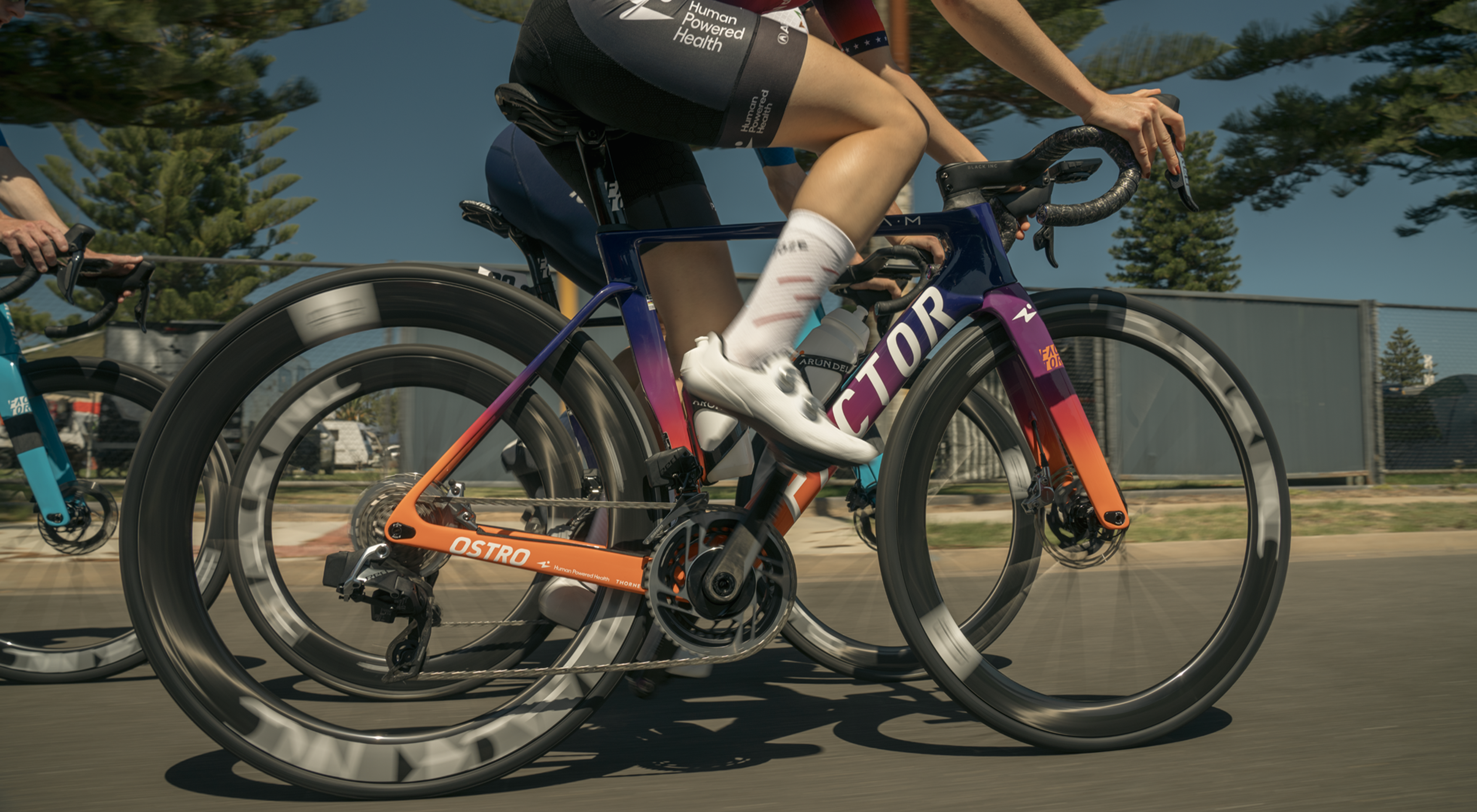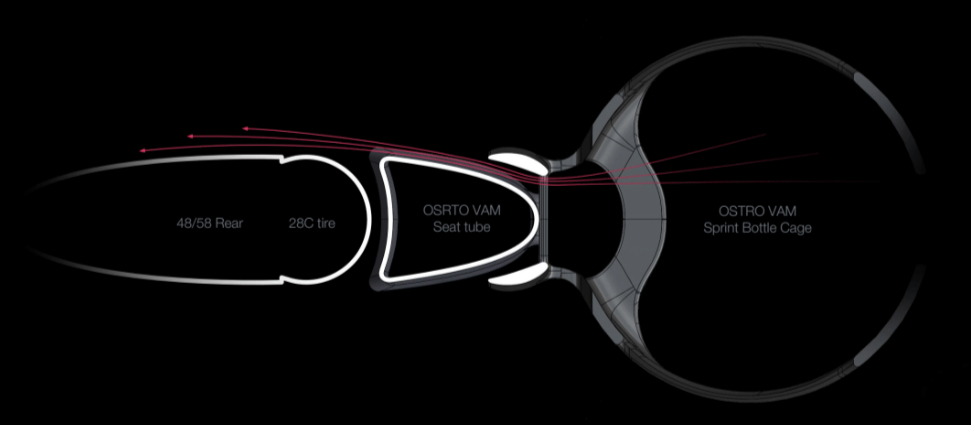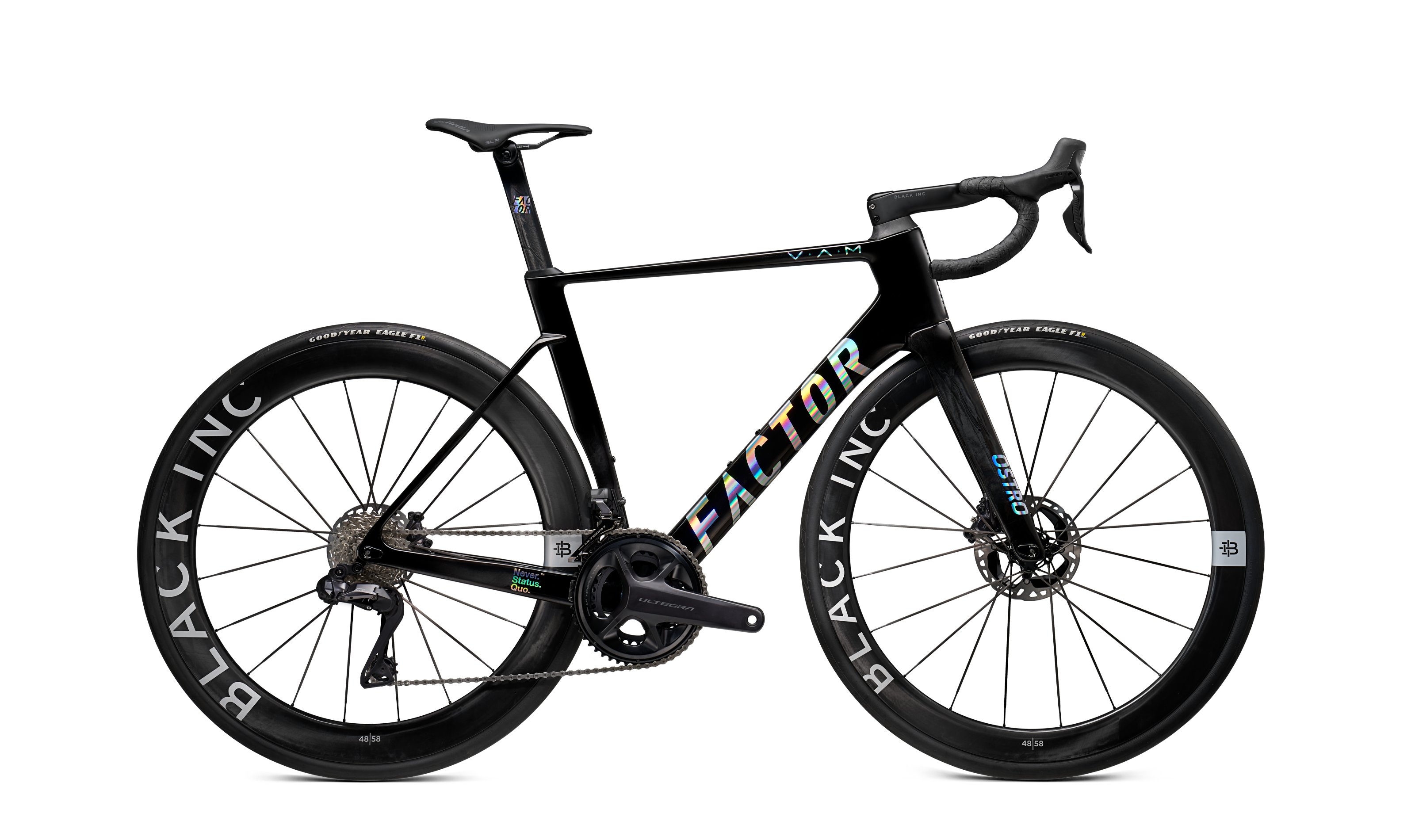
First seen at the Australian National Road Race championships and then in detail at the Tour Down Under, the news that Factor is launching an all-new Ostro will shock nobody, but today is the day that the brand's aero bike gets its big reveal.
Complete with 'Zoned aero development,' it follows the trend du jour of focussing on aero performance at the front of the bike and reducing weight at the rear, in a bid to have as fast a bike as possible while also sticking as closely as possible to the UCI minimum weight limit of 6.8kg.
It does this despite Factor also having the lightweight O2 VAM in its range, and marks a slight shift in the brand's communication of that bike from its best all-rounder race bike to something more aimed at leisure riders.
The launch also sees the introduction of another pair of Black Inc wheels. Similar to how the O2 VAM was accompanied by the 28/33 wheelset, today's Ostro VAM launch is accompanied by the new 48/58 wheels; unsurprisingly a deeper option more suited to the bike's aero aims.
Naturally, the Daft Punk-style claims of faster, lighter, better, stronger also accompany the launch, including a seven watt improvement in aerodynamic performance at 48kph, borne out of a CdA improvement of 0.0055.
There's also a claimed weight reduction of (a very specific) 267.8 grams for the 'premium package with wheels'. A 56cm frame in the raw carbon colourway is reportedly 820g. We'll get into the details where this saving was achieved shortly.
Factor also claims a saving of over two minutes across Stage 9 of the 2023 Tour de France (which Michael Woods won on the outgoing OSTRO, hence its relevance).

Zoned development
As is becoming increasingly common in bike launches of late, Factor wanted to squeeze all the aero gains out of the front of the bike and focus more on weight reduction at the rear.
To this end, the brand worked from front to back shaping the front of the bike to help steer the airflow favourably around the rest of the bike and the rider.
Engineers also split the bike into five zones; fork, head tube, top tube, seat tube and downtube. Each was given targets related to aerodynamic performance, weight and stiffness, with a broad aim to increase aerodynamics, reduce weight, while maintaining a similar stiffness to the outgoing Ostro VAM.
For the fork, Factor says "we would only accept an aerodynamic gain if it could be achieved without compromising weight and stiffness" and it claims to have achieved this thanks to an adjusted fork leg shape, reduced frontal area, and a reduced fork crown height.
Interestingly, so called "small surface details" have been added to the inside of the fork legs to improve airflow next to the rotating wheel. The fork legs are also slightly deeper than before, coupled with a nose cone built into the head tube - another en vogue addition to race bikes of late.
Speaking of the head tube - or zone two in Factor's parlance - Factor has given this a more sculpted hourglass shape, which it claims offers longer attachment of airflow at all yaw angles, with the added benefit of using less material, thus dropping the weight too. Factor says this shape also guides airflow along the underside of the top tube and between the rider's legs, rather than directly into them.
Zone three - the top tube to you and me - was given the primary aim of capturing that airflow and directing it to the rear of the bike. Visually there's not a lot going on here that screams aerodynamics, but like the O2 VAM, it tapers toward the rear, albeit less dramatically.
Zone four is where things get tricksy. Given the change in the UCI's rules governing tube shapes, Factor was able to develop a seatpost that's thinner than before, and thus the seat tube followed it on its Slimmingworld journey. This enabled the tapering of the top tube, while reducing the frontal area and total material used.
It's here that the new seatpost clamp can be seen too. Unlike the O2 VAM, it sticks with a standard seatpost rather than a mast and a topper, but rather than a top-down wedge clamp as seen on the old Ostro, the new bike gets a two-bolt 'pusher' clamp, which essentially expands and pushes into the rear of the seatpost to hold it in place.
Factor says the new Ostro Vam seatpost is 36% slimmer than before. The seatpost is 20% thinner, but slightly longer to house the seatpost clamp. The seat tube is also shifted rearward slightly, and is now designed with a slight curve to wrap around the rear wheel. The concave rear face of the tube is designed to neatly shroud a 28mm tyre.
To round off the zones, the fifth relates to the bottom bracket junction. Here, Factor says that only a few subtle refinements were made, and CdA improvements were seen, but overall the aero, weight and stiffness remain unchanged.

Rule-bending bottle cages
Perhaps the sneakiest feature of the Ostro VAM is not a part of the bike itself, but the proprietary bottle cages that come with it. Like most road bikes, it can hold two cages, but they differ from each other. Similar to the BMC bottle cages found on the Timemachine Road and others, the downtube bottle cage is designed to sit as closely as possible, bridging the gap between the frame and the bottle with built up sidewalls that help air flow off the downtube and around the bottle.
The seat tube bottle cage, however, is designed slightly differently. It still has those similar sides that let air flow off the bottle and onto the frame, but on the inside of those is a channel that guides air past the frame when a rider has discarded the bottle.
Based on leading edge slats on an aeroplane's wings (which extend at take-off and landing to provide better lift at lower speeds), they help the air flow onto the seat tube, which then passes it onto the tyre and the rim.
Factor says the bike is actually more aerodynamic with an empty bottle cage here than without one at all.

New Black Inc wheels
Accompanying the new Ostro VAM is a new pair of wheels from Factor's in-house component brand, Black Inc. They're called the 48/58, and as the name suggests are 48mm deep at the front and 58mm deep at the rear.
Impressively, they weigh just 1,270g per pair, which for a 48/58mm deep disc brake wheelset, is an incredibly small number of grams; market leading in fact. Only Syncros' one-piece wheels with moulded carbon spokes are really able to compete on paper (at 1290g for 60mm front and rear), although Cadex's latest 50mm Ultra wheels get reasonably close at 1316g.
They are optimised for 28mm tyres, have a 23mm internal width, and boast a high-flange hub which Factor reckons contributes an improved lateral stiffness and ride feel.
The weights
Despite Factor's incredibly specific claim that the new Ostro VAM is 268.2 grams lighter than the outgoing model for the "premium package with wheels," there are some figures that require further clarification, which Factor did help explain when asked.
The launchbook for the Ostro VAM states that the new frame weighs 820g versus 865.2g for the outgoing model (size 54cm, black/chrome). However, the listing page for the outgoing Ostro VAM on Factor's website states that it weighs 830g.
Similarly, when comparing the new 48/58 wheels with the FortyFive, the launchbook states a difference of 219 grams, by virtue of the new wheels weighing 1270g and the old wheels weighing 1489g. Despite this, Factor's website states that the FortyFive weigh 1542g.
This discrepancy is down to the fact that the Ostro VAM weight listed on the website is for a matte black (effectively unpainted) colourway, while the 862.5g figure is for a painted frame. The new frame weight is also painted. and so Factor says a 820g vs 862.5g is a like-for-like comparison.
At the time of writing we are yet to recieve a clarification on the wheel weights, but I think it's important to clarify that whatever the differences are, be they frame or wheel, they would fall well within the margin of difference between two identical frames anyway. When Bianchi launched the Specialissima, it said the bike weight was "6.6kg accurate to +/- 5%" which meant it could actually weigh anywhere between 6.27kg and 6.93kg. Given that range equated to 660 grams, a few-dozen here is forgivable.

Price and availability
The Ostro is aimed squarely at the top end of the market, with a complete bike starting price of £8,999 (US $9,199 / €8,849) complete with Shimano Ultegra Di2. It tops out at £11,399 (US $11,499 / €11,049) for a SRAM Red eTap equipped model with Quarq power meter. All complete bikes come with the Black Inc 48/58 wheels and one-piece bar-stem.
A frameset is priced at £5,449 (US $5,499 / €5,799).
Bikes are available in stores and online immediately, across sizes 45 to 61cm.







